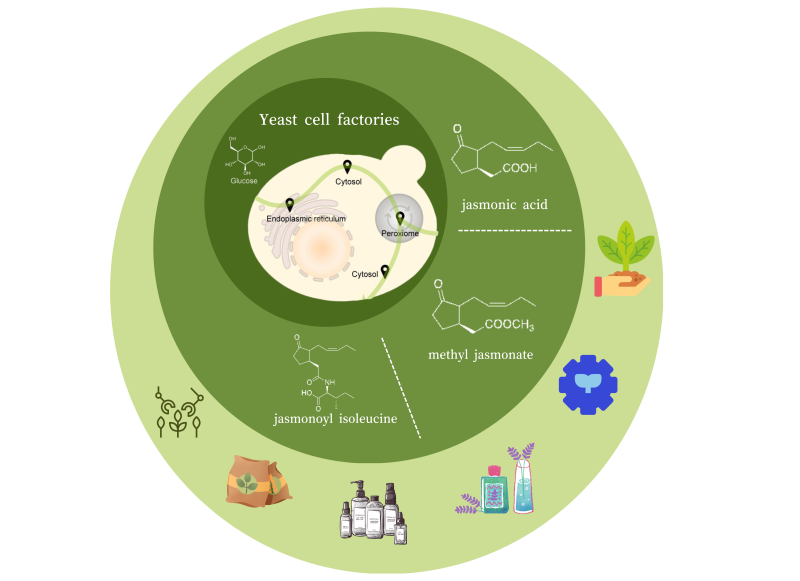Ingenious Yeast Engineering Unveils New Frontiers in Jasmonate Biosynthesis
Date:14-11-2023 | 【Print】 【close】
A research team led by Prof. LUO Xiaozhou from the Shenzhen Institute of Advanced Technology (SIAT) of the Chinese Academy of Sciences (CAS) and Prof. Jay D. Keasling from the University of California, Berkeley, has developed an engineered baker’s yeast to produce to produce vital plant hormones known as jasmonates, including jasmonic acid and its derivatives, methyl jasmonate and jasmonoyl isoleucine.
The study was published in Nature Synthesis on Nov. 13.
Jasmonic acid and its derivatives are collectively called jasmonates, which are like the Swiss Army knives of plant hormones, playing a key role in plant growth, stress responses, and defense mechanisms. They also hold potential in medicinal applications. However, extracting these hormones from plants is like finding a needle in a haystack – extremely low yield and environmentally taxing.
Saccharomyces cerevisiae has been widely used for industrial production of biochemicals. It harbours various organelles that are essential for reconstitution of plant pathways with multiple enzymes and different native locations.
Jasmonates biosynthesis is a complex, multienzyme-catalysed process that exhibits extensive compartmentalization, with enzymes active across the chloroplast, peroxisome and cytosol. The chloroplast is the compartment for production of the precursors α-LeA and OPDA. As yeast does not have a chloroplast, reconstitution of the jasmonates pathway presents a challenge as a result of the incompatibilities of enzymes adapted for unusual contexts.
To address these challenges, the researchers used enzymes located in the endoplasmic reticulum and cytosol to generate the intermediates α-LeA and OPDA. Genome editing was performed using the parent strain Lab001, and the final engineered strain, which integrated 15 heterologous genes from diverse plants and fungi and had 3 of its native genes deleted, produced jasmonic acid at titres of 9.6 mg·L-1 in flask cultures. Further strain engineering also enabled the production of 3.1 mg·L-1 methyl jasmonate and 7.0 mg·L-1 jasmonoyl isoleucine, respectively.
Prof. LUO Xiaozhou explains, "Our work is not just a technical marvel; it’s a gateway to creating agricultural aids that help crops withstand stress and diseases, and it holds the potential for novel medical treatments." This technique offers a more efficient, cost-effective, and environmentally friendly method than current chemical synthesis or extraction processes.
The study is just the beginning. The team is already exploring ways to scale up production, aiming to bring this technology to commercial viability. This could mean stronger, healthier crops and new medical treatments in the near future, marking a significant leap forward in biotechnology.
"The chemical synthesis of jasmonates is typically low yielding and can be laborious, whereas their extraction can be costly or environmentally hazardous. Now a de novo biosynthesis of jasmonic acid and its derivatives, methyl jasmonate and jasmonoyl isoleucine is reported, using an engineered baker’s yeast," said Editor Thomas West.

Engineering biosynthetic pathway for de novo production of jasmonates in S. cerevisiae. (Image by Prof. LUO)
Media Contact:
ZHANG Xiaomin
Email:xm.zhang@siat.ac.cn